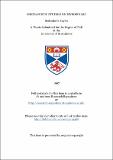Files in this item
Mechanistic studies on myrosinase
Item metadata
| dc.contributor.advisor | Botting, Nigel | |
| dc.contributor.author | Taylor, Malcolm G. | |
| dc.coverage.spatial | 285 p. | en_US |
| dc.date.accessioned | 2018-06-21T08:21:33Z | |
| dc.date.available | 2018-06-21T08:21:33Z | |
| dc.date.issued | 1997 | |
| dc.identifier.uri | https://hdl.handle.net/10023/14368 | |
| dc.description.abstract | Myrosinase is the beta-thioglucosidase enzyme which catalyses the hydrolysis of glucosinolates, a group of naturally occurring plant metabolites. Glucosinolates are S-glucosides which occur predominantly in the family Cruciferae, and are abundant in the Brassica vegetables. The hydrolysis reaction, specifically activated by L-ascorbic acid, gives beta-D-glucose and an aglucone fragment, which then rearranges to give sulfate and an isothiocyanate. The aim of this study was the investigation of the chemical mechanism of myrosinase, in order for it to be compared with those of the much more widely studied (3-glycosidases. Myrosinase catalysed transglycosylation reactions were examined as a potential synthetic method. However, no transglycosylation was detected, even though a wide range of glycosyl acceptors was examined, including simple alcohols and thiols and examples with charged side chains to mimic the glucosinolate. Such reactions are commonly observed with beta-glycosidases. However, the stability and activity of myrosinase was not substantially affected by the presence of the acceptors. A small amount of transglycosylation was observed using azide, a charged glycosyl acceptor. This is consistent with the other transglycosylation reactions failing due to the lack of a suitable basic residue at the active site to deprotonate the acceptor. A range of potential substrates was synthesised, although only the nitrophenyl-p-D-glucosides showed any substrate activity. All S-glucosides were inactive. Myrosinase therefore appears to be very specific. Inhibition studies revealed that D-glucono-y-lactone, a potent competitive inhibitor and transition state mimic of p-glucosidases, was a poor noncompetitive inhibitor of myrosinase. It was proposed that this inhibitor binds at the L-ascorbic acid activator site. The inhibitory properties of a number of other compounds were examined, including reaction products and potential substrates (S-glucosides). [1-2H]-Sinigrin, p-nitrophenyl- and 2,4-dinitrophenyl-beta-D-[1-2H]-glucoside were prepared to measure the secondary deuterium isotope effects. The isotope effect obtained for 2,4-dinitrophenyl-p-D-[1-2H]-glucoside (DV= 1.26 +/- 0.11) indicated an sp2 hybridised intermediate via an SN1-Iike mechanism. The solvent kinetic isotope effect for sinigrin hydrolysis was determined (DV = 1.54 +/- 0.07, DV/K = 1.24 +/- 0.15) implying that a proton transfer was partially rate limiting. | en_US |
| dc.language.iso | en | en_US |
| dc.publisher | University of St Andrews | |
| dc.subject.lcc | QP609.G4T2 | |
| dc.subject.lcsh | Glucosidases | en |
| dc.title | Mechanistic studies on myrosinase | en_US |
| dc.type | Thesis | en_US |
| dc.type.qualificationlevel | Doctoral | en_US |
| dc.type.qualificationname | PhD Doctor of Philosophy | en_US |
| dc.publisher.institution | The University of St Andrews | en_US |
This item appears in the following Collection(s)
Items in the St Andrews Research Repository are protected by copyright, with all rights reserved, unless otherwise indicated.

